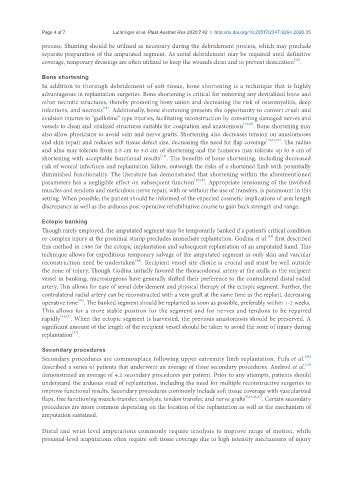Page 480 - Read Online
P. 480
Page 4 of 7 Luthringer et al. Plast Aesthet Res 2020;7:42 I http://dx.doi.org/10.20517/2347-9264.2020.35
process. Shunting should be utilized as necessary during the debridement process, which may preclude
separate preparation of the amputated segment. As serial debridement may be required until definitive
[18]
coverage, temporary dressings are often utilized to keep the wounds clean and to prevent desiccation .
Bone shortening
In addition to thorough debridement of soft tissue, bone shortening is a technique that is highly
advantageous in replantation surgeries. Bone shortening is critical for removing any devitalized bone and
other necrotic structures, thereby promoting bony union and decreasing the risk of osteomyelitis, deep
[19]
infections, and necrosis . Additionally, bone shortening presents the opportunity to convert crush and
avulsion injuries to “guillotine” type injuries, facilitating reconstruction by converting damaged nerves and
vessels to clean and vitalized structures suitable for coaptation and anastomosis [19,20] . Bone shortening may
also allow physicians to avoid vein and nerve grafts. Shortening also decreases tension on anastomoses
and skin repair and reduces soft tissue defect size, decreasing the need for flap coverage [19,21,22] . The radius
and ulna may tolerate from 2.5 cm to 5.0 cm of shortening and the humerus may tolerate up to 8 cm of
[13]
shortening with acceptable functional results . The benefits of bone shortening, including decreased
risk of wound infections and replantation failure, outweigh the risks of a shortened limb with potentially
diminished functionality. The literature has demonstrated that shortening within the aforementioned
parameters has a negligible effect on subsequent function [15,19] . Appropriate tensioning of the involved
muscles and tendons and meticulous nerve repair, with or without the use of transfers, is paramount in this
setting. When possible, the patient should be informed of the expected cosmetic implications of arm length
discrepancy as well as the arduous post-operative rehabilitative course to gain back strength and range.
Ectopic banking
Though rarely employed, the amputated segment may be temporarily banked if a patient’s critical condition
[23]
or complex injury at the proximal stump precludes immediate replantation. Godina et al. first described
this method in 1986 for the ectopic implantation and subsequent replantation of an amputated hand. This
technique allows for expeditious temporary salvage of the amputated segment as only skin and vascular
reconstruction need be undertaken . Recipient vessel site choice is crucial and must be well outside
[24]
the zone of injury. Though Godina initially favored the thoracodorsal artery at the axilla as the recipient
vessel in banking, microsurgeons have generally shifted their preference to the contralateral distal radial
artery. This allows for ease of serial debridement and physical therapy of the ectopic segment. Further, the
contralateral radial artery can be reconstructed with a vein graft at the same time as the replant, decreasing
[24]
operative time . The banked segment should be replanted as soon as possible, preferably within 1-2 weeks.
This allows for a more stable position for the segment and for nerves and tendons to be repaired
rapidly [24,25] . When the ectopic segment is harvested, the previous anastomosis should be preserved. A
significant amount of the length of the recipient vessel should be taken to avoid the zone of injury during
[24]
replantation .
Secondary procedures
Secondary procedures are commonplace following upper extremity limb replantation. Fufa et al.
[26]
[19]
described a series of patients that underwent an average of three secondary procedures. Axelrod et al.
demonstrated an average of 4.2 secondary procedures per patient. Prior to any attempts, patients should
understand the arduous road of replantation, including the need for multiple reconstructive surgeries to
improve functional results. Secondary procedures commonly include soft tissue coverage with vascularized
flaps, free functioning muscle transfer, tenolysis, tendon transfer, and nerve grafts [6,19,26,27] . Certain secondary
procedures are more common depending on the location of the replantation as well as the mechanism of
amputation sustained.
Distal and wrist level amputations commonly require tenolysis to improve range of motion, while
proximal-level amputations often require soft tissue coverage due to high intensity mechanisms of injury

